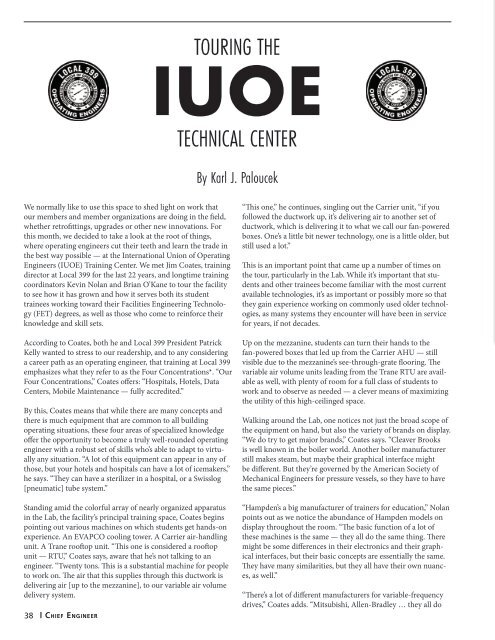CEAC-2022-08-August
You also want an ePaper? Increase the reach of your titles
YUMPU automatically turns print PDFs into web optimized ePapers that Google loves.
TOURING THE<br />
IUOE<br />
TECHNICAL CENTER<br />
By Karl J. Paloucek<br />
We normally like to use this space to shed light on work that<br />
our members and member organizations are doing in the field,<br />
whether retrofittings, upgrades or other new innovations. For<br />
this month, we decided to take a look at the root of things,<br />
where operating engineers cut their teeth and learn the trade in<br />
the best way possible — at the International Union of Operating<br />
Engineers (IUOE) Training Center. We met Jim Coates, training<br />
director at Local 399 for the last 22 years, and longtime training<br />
coordinators Kevin Nolan and Brian O’Kane to tour the facility<br />
to see how it has grown and how it serves both its student<br />
trainees working toward their Facilities Engineering Technology<br />
(FET) degrees, as well as those who come to reinforce their<br />
knowledge and skill sets.<br />
According to Coates, both he and Local 399 President Patrick<br />
Kelly wanted to stress to our readership, and to any considering<br />
a career path as an operating engineer, that training at Local 399<br />
emphasizes what they refer to as the Four Concentrations*. “Our<br />
Four Concentrations,” Coates offers: “Hospitals, Hotels, Data<br />
Centers, Mobile Maintenance — fully accredited.”<br />
By this, Coates means that while there are many concepts and<br />
there is much equipment that are common to all building<br />
operating situations, these four areas of specialized knowledge<br />
offer the opportunity to become a truly well-rounded operating<br />
engineer with a robust set of skills who’s able to adapt to virtually<br />
any situation. “A lot of this equipment can appear in any of<br />
those, but your hotels and hospitals can have a lot of icemakers,”<br />
he says. “They can have a sterilizer in a hospital, or a Swisslog<br />
[pneumatic] tube system.”<br />
Standing amid the colorful array of nearly organized apparatus<br />
in the Lab, the facility’s principal training space, Coates begins<br />
pointing out various machines on which students get hands-on<br />
experience. An EVAPCO cooling tower. A Carrier air-handling<br />
unit. A Trane rooftop unit. “This one is considered a rooftop<br />
unit — RTU,” Coates says, aware that he’s not talking to an<br />
engineer. “Twenty tons. This is a substantial machine for people<br />
to work on. The air that this supplies through this ductwork is<br />
delivering air [up to the mezzanine], to our variable air volume<br />
delivery system.<br />
38<br />
| Chief Engineer<br />
“This one,” he continues, singling out the Carrier unit, “if you<br />
followed the ductwork up, it’s delivering air to another set of<br />
ductwork, which is delivering it to what we call our fan-powered<br />
boxes. One’s a little bit newer technology, one is a little older, but<br />
still used a lot.”<br />
This is an important point that came up a number of times on<br />
the tour, particularly in the Lab. While it’s important that students<br />
and other trainees become familiar with the most current<br />
available technologies, it’s as important or possibly more so that<br />
they gain experience working on commonly used older technologies,<br />
as many systems they encounter will have been in service<br />
for years, if not decades.<br />
Up on the mezzanine, students can turn their hands to the<br />
fan-powered boxes that led up from the Carrier AHU — still<br />
visible due to the mezzanine’s see-through-grate flooring. The<br />
variable air volume units leading from the Trane RTU are available<br />
as well, with plenty of room for a full class of students to<br />
work and to observe as needed — a clever means of maximizing<br />
the utility of this high-ceilinged space.<br />
Walking around the Lab, one notices not just the broad scope of<br />
the equipment on hand, but also the variety of brands on display.<br />
“We do try to get major brands,” Coates says. “Cleaver Brooks<br />
is well known in the boiler world. Another boiler manufacturer<br />
still makes steam, but maybe their graphical interface might<br />
be different. But they’re governed by the American Society of<br />
Mechanical Engineers for pressure vessels, so they have to have<br />
the same pieces.”<br />
“Hampden’s a big manufacturer of trainers for education,” Nolan<br />
points out as we notice the abundance of Hampden models on<br />
display throughout the room. “The basic function of a lot of<br />
these machines is the same — they all do the same thing. There<br />
might be some differences in their electronics and their graphical<br />
interfaces, but their basic concepts are essentially the same.<br />
They have many similarities, but they all have their own nuances,<br />
as well.”<br />
“There’s a lot of different manufacturers for variable-frequency<br />
drives,” Coates adds. “Mitsubishi, Allen-Bradley … they all do

















